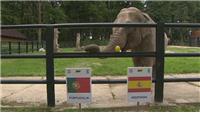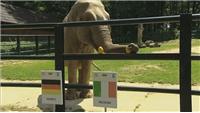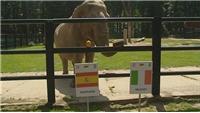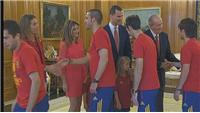
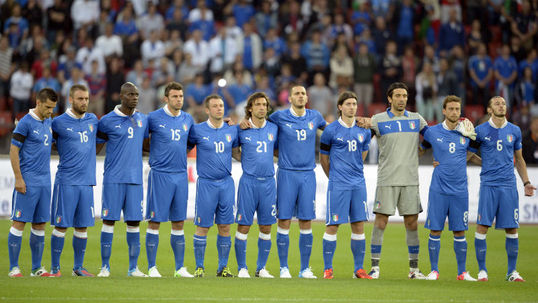
Italy are rocked by the Scommessopoli scandal, look poor coming into the Euros and are in the midst of an injury crisis.
Nonetheless, the signs point to a strong showing from them this time around.
For all their off-field troubles, Italy do have one of the most technically gifted sides in the competition and it would be foolish to write them off from the start.
The three-man defense
Tactics have always been Italy's strong suit and it's no different this time round.
The Azzurri's strength is in the middle of the pitch, where they have an array of talented men like Andrea Pirlo, Daniele De Rossi, Antonio Nocerino, Riccardo Montolivo and Claudio Marchisio.
The best way that manager Cesare Prandelli can use them is going how the Italian clubs play - by putting three central midfielders with a three-man defence.
Parma, Napoli, Udinese, Juventus, Bologna, Catania and Atalanta all utilised at some point or the other through the season and the players in Prandelli's squad will be more familiar with the drill-heavy formation.
Leonardo Bonucci, Andrea Barzagli, Giorgio Chiellini and Andrea Ranocchia are all big, mobile centre-backs who played in a three-man defence for most of last season and are familiar with each other while Cristian Maggio and Emmanuele Giaccherini were two of the most outstanding center backs in the Serie A last season.
Higher up in the middle, Daniele De Rossi had an excellent season after reverting to a defensive midfield role, winning the ball and looking dangerous when going up. He's the perfect foil for Andrea Pirlo's amazing passing skills, creating a partnership similar to the winning Pirlo-Vidal combo at Juventus that proved to be superb in controlling games.
Up front, Sebastian Giovinco is currently one of the world's best when linking up the ball from midfield to attack as a trequartista. Combine him with the now-mature Antonio Cassano, the Azzurri have one of the most intelligent strike forces at the Euros (Balotelli jokes notwithstanding).
How does it work?
'So how does a three-man defence work, and why is it so effective?' you may wonder.
Three mobile defenders allow an extra man to sweep up the excess. The wing backs are essentially wide midfielders who go forward from a deeper position, using the extra space in front of them to charge at defenders while covering back at every threat.
In this 3-5-2 set-up, De Rossi and Pirlo will sit deeper to protect the back three while pulling the strings for the Azzurri.
The tactic is especially effective against the 4-2-3-1 and 4-3-3 which are all the rage nowadays because of the extra width that it provides deeper in midfield while providing an extra man to facilitate the ball travelling across the width of the pitch.
Most importantly, it is economical at the back, using only three men (as compared to the usual four) and frees up an extra man further forward. Basically, it's almost like having an opponent sent off even before the game has started.
It's actually not a new trend in football - the impact of a three-man defence has been witnessed throughout the continent last season.
Napoli shocked Manchester City at the group stages of the Champions League, Arsenal got a nasty surprise from Udinese in the Champions League qualifying match, Wigan switched to a 3-4-3 formation at the turn of the year and suddenly had the quality to match both Manchester sides, Arsenal, Liverpool and Newcastle.
Opponents are caught out by not being sure where or how to deal with the extra man that provides the movement.
A prime case is when Newcastle, the revelation of the Premier League last season, were thrashed 4-0 by Wigan. When Pardew met against Wigan, he set out a 4-3-3 formation.
Wigan's wing backs outnumbered Newcastle at the back when the extra midfield man popped up to assist the wingers and it resulted in two early goals. Pardew then reverted to a 3-4-3 himself, but his players were not used to that formation and the Magpies ended up losing 4-0.
The only way to counter this formation is by lumping the ball forward, entirely bypassing the midfield and using the wingers very high up to launch a counter-attack, like what Arsenal and Chelsea did against Udinese and Napoli respectively.
Tactically speaking, this is ideal for them as they have Spain the group.
Spain are the perfect opponents for Italy. The Spaniards love to keep the ball on the ground and seem hell-bent on not hoofing the ball upfield - just the side for Prandelli's men to implement their midfield battle-plan against.
Scommessopoli distraction
Of course, it's not all rosy for Italy with their domestic problems plaguing them right before the start of the competition.
Six years after the Calciopoli saga, the ugly side of football reared its head in Italy again with the Scommessopoli scandal.
Juventus manager Antonio Conte, Lazio captain Stefano Mauri and Domenico Criscito have all been questioned and the latter was withdrawn from the Azzurri squad when news of his involvement broke.
Shorn of one of their best full backs in Crsicito, the core of the squad, who are Juventus players, also have their club manager's fate to worry about.
If there's something a team doesn't need at a major tournament, it's a negative press. Just ask England.
Signs and omens
However, if you subscribe more to the superstitious side of football, then Italy may already be your pick to win the competition given that all of Italy's recent triumphs seem to have come amidst scandals and Juventus wins.
In 1982, Juventus won the Scudetto and Italy were reeling from the 'Totonero' betting scandal. A total of 50 years of bans were handed out to the culprits, while various teams incurred a total of 25 deducted points.
The Azzurri's star striker Paolo Rossi missed two years of football and returned just in time for the 1982 World Cup despite being, according to the press, 'out of shape'.
In 2006, Juventus won the Scudetto and the Calciopoli scandal rocked Italian football. Juventus themselves were relegated from the Serie A and a string of other clubs were deducted points for their involvement.
Italy went on to win the 2006 World Cup, lifting the trophy after beating France in the final.
If that still isn't enough, try this - the last time Manchester City won the Premier League title in 1968, Italy won the European Championships.
Italy squad
Goalkeepers: Gianluigi Buffon (Juventus), Salvatore Sirigu (Paris Saint-Germain), Morgan De Sanctis (Napoli).
Defenders: Cristian Maggio (Napoli), Ignazio Abate (AC Milan), Federico Balzaretti (Palermo), Leonardo Bonucci (Juventus), Andrea Barzagli (Juventus), Giorgio Chiellini (Juventus), Andrea Ranocchia (Inter Milan), Angelo Ogbonna (Torino).
Midfielders: Andrea Pirlo (Juventus), Claudio Marchisio (Juventus), Emanuele Giaccherini (Juventus), Daniele De Rossi (Roma), Thiago Motta (Paris Saint-Germain), Antonio Nocerino (AC Milan), Riccardo Montolivo (Fiorentina), Alessandro Diamanti (Bologna).
Strikers: Antonio Cassano (AC Milan), Mario Balotelli (Manchester City), Sebastian Giovinco (Parma), Antonio Di Natale (Udinese), Mattia Destro (Siena), Fabio Borini (Roma).
- Arbeloa: Spain must never change their style
- Wedding bells turn Iniesta's legs to jelly
- Pele: Brazil's 1970 World Cup winners better than Spain
- Pirlo: Only Spain are superior to Italy
- Spain disproved boring tag with empathic final win, insists Alonso
- Fernando Torres revels in Euro 2012 crown
- Italy can reach the final at World Cup 2014
- Johan Cruyff: I enjoyed Italy and I'm a big fan of Del Bosque's Spain
- De Gea & Mata named in Olympics squad
- Shevchenko: Euro 2012 was a success for Ukraine
Hot News
- Funny Balotelli!
- Spanish fans celebrate Euro Cup win
- That's German WAGS!
- The sexy female fans in Euro 2012
- Euro 2012: Spain fans celebrate victory
- Spain vs Italy in clash of the Euro WAGs
- Euro 2012 Final - Spain 4 : 0 Italy, Part 2
- Germany knocked out by Italy
- Natalia Siwiec blasts Sol and the BBC
- Coleen Rooney reveals her bikini body secrets
- Italy's fans celebrated wildly
- Euro 2012 Final - Spain 4 : 0 Italy, Part 1
| Rank | Team | W/D/L | Pts |
|---|
Cities & Stadiums
The Top 3 Teams of Previous Tournaments
| Year | Winners | Runner-up | Third place |
|---|---|---|---|
| 2008 | Spain | Germany | Russia / Turkey |
| 2004 | Greece | Portugal | Netherlands / Czech Republic |
| 2000 | France | Italy | Netherlands / Portugal |
| 1996 | Germany | Czech Republic | France / England |
| 1992 | Denmark | Germany | Netherlands / Sweden |
| 1988 | Netherlands | Soviet Union | Italy / West Germany |
| 1984 | France | Spain | Denmark / Portugal |
| 1980 | West Germany | Belgium | Czechoslovakia |
| 1976 | Czechoslovakia | West Germany | Netherlands |
| 1972 | West Germany | Soviet Union | Belgium |
| 1968 | Italy | Yugoslavia | England |
| 1964 | Spain | Soviet Union | Hungary |
| 1960 | Soviet Union | Yugoslavia | Czechoslovakia |

